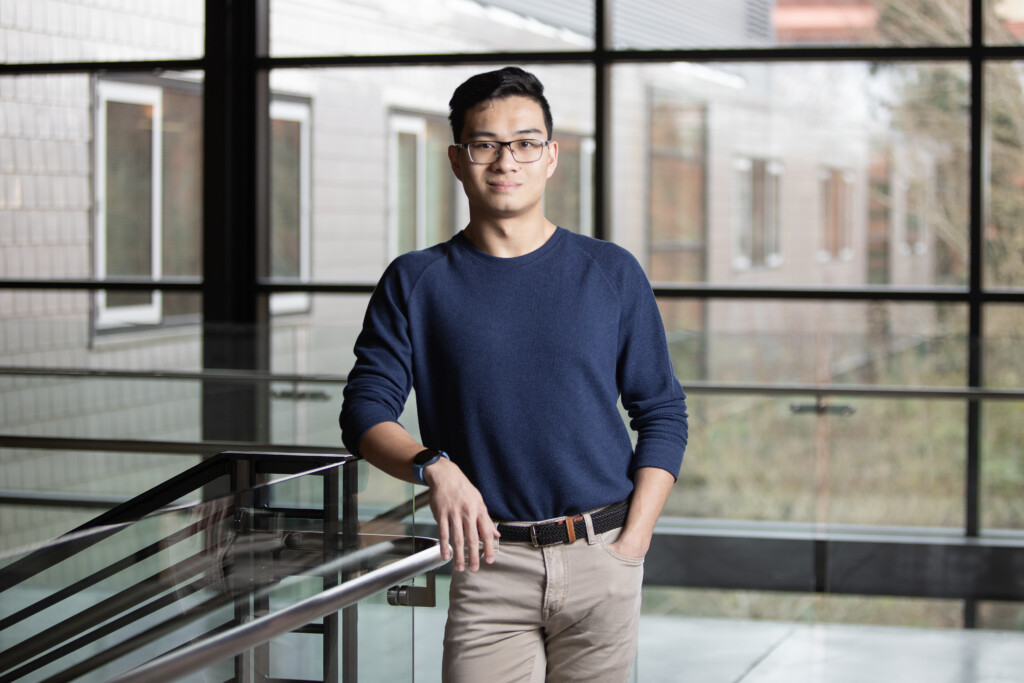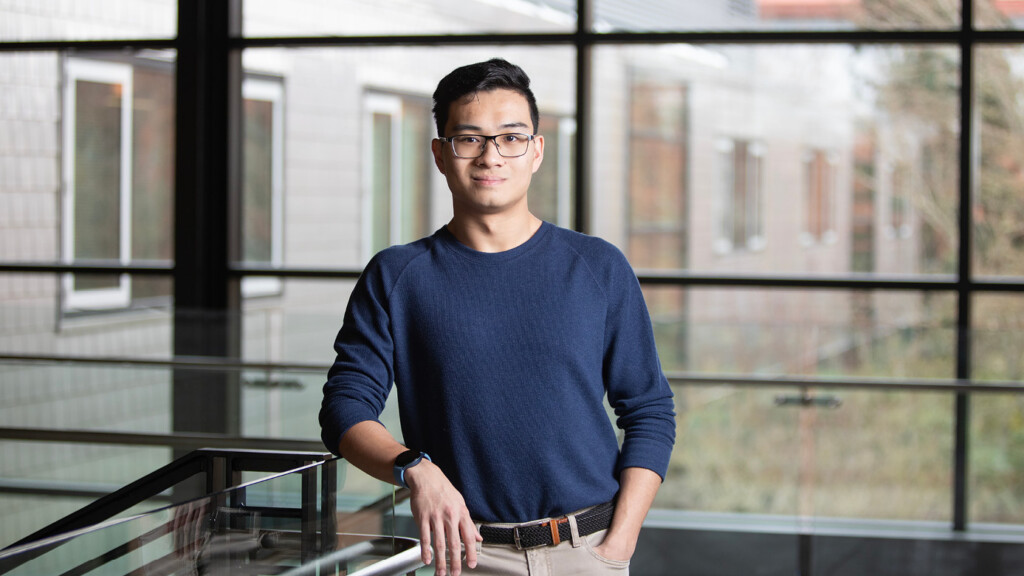Page 2 • (295 results in 0.034 seconds)
-

TACOMA, WASH. (March 8, 2019) — A prestigious $650,000 grant from the National Science Foundation (NSF) will support academically talented low-income students who come to Pacific Lutheran University to study STEM (Science,Technology, Engineering and Math) subjects. Winning the grant was a team effort of PLU’s…
students in STEM, but it will also allow us to better integrate PLU resources and build new structures to support these students’ success.” The grant, funded by the NSF Scholarships in Science, Technology, Engineering, and Mathematics (S-STEM) program, will be awarded over a five-year period. It will provide scholarships and enhanced support for students who meet the criteria for federal Pell grants, with a particular focus on transfer and commuter students. Sixty percent of the funds will provide
-

TACOMA, WASH. (Jan. 6, 2020) — Basketball drew Kell Duncan ‘11 from Arizona to Pacific Lutheran University. But while he loved his time playing forward and center for the Lutes, he was far less certain about his initial choice of major. “Business school wasn’t a…
co-working office space.” Rodie was developing his own plans for a bar and restaurant, and the two men decided to join forces. The result was the Churchill, a collective of small businesses that has become a hip destination since it opened in September 2018. Duncan and Rodie’s concept stood out for two main reasons. First, the Churchill’s restaurants, bars and retail shops are housed in repurposed shipping containers that share a 9,000-square-foot courtyard. Such recycled structures existed in
-

Meet Brian Sung, a business major from the class of ’24 at PLU. When he’s not taking international honors courses or diving deep into his double majors in business and economics , he’s all about data science and statistics through his double minors. Outside of…
Brian Sung ’24 talks business, econ majors, Oxford adventure, and his unique PLU journey as a first-gen Chinese immigrant Posted by: mhines / March 21, 2024 March 21, 2024 By By Fulton Bryant-Anderson ’23 PLU Marketing & Communications Guest Writer Meet Brian Sung, a business major from the class of ’24 at PLU. When he’s not taking international honors courses or diving deep into his double majors in business and economics, he’s all about data science and statistics through his double minors
-

Travis McDaneld ’23 is entering his fourth year at PLU as an economics major, minoring in data science. When he enrolled at PLU, he had every intention of majoring in business, although he admits to not having any idea about what he wanted to do…
Summer Internships: Economics Posted by: vcraker / September 7, 2022 September 7, 2022 Travis McDaneld ’23 is entering his fourth year at PLU as an economics major, minoring in data science. When he enrolled at PLU, he had every intention of majoring in business, although he admits to not having any idea about what he wanted to do after graduation. But when he took a microeconomics class, he says it all clicked, and he knew what he wanted to study. Through The Alumni & Student Connections
-
Oregon Health and Science University (OHSU) graduate students will develop a broad understanding across biomedical disciplines with strong foundations in quantitative literacy and critical thinking. This allows our students to identify important biomedical questions, design and execute experimental approaches, conduct data analysis and interpretation, and…
Virtual Open House – Oregon Health and Science University Posted by: nicolacs / September 24, 2021 September 24, 2021 Oregon Health and Science University (OHSU) graduate students will develop a broad understanding across biomedical disciplines with strong foundations in quantitative literacy and critical thinking. This allows our students to identify important biomedical questions, design and execute experimental approaches, conduct data analysis and interpretation, and communicate rigorous
-

Brian Sung ’24 has made the most out of his PLU years inside and outside the classroom. In the classroom, he’s an international honors student with a double major in business and economics and a double minor in data science and statistics. Outside the classroom,…
Brian Sung ’24 discusses his business and econ majors, Oxford trip, and PLU experience as a first generation Chinese immigrant Posted by: tpotts / April 4, 2024 April 4, 2024 Brian Sung ’24 has made the most out of his PLU years inside and outside the classroom. In the classroom, he’s an international honors student with a double major in business and economics and a double minor in data science and statistics. Outside the classroom, he’s served as DECA Club president, a resident assistant, and
-

Travis McDaneld ’23 is entering his fourth year at PLU as an economics major, minoring in data science. When he enrolled at PLU, he had every intention of majoring in business, although he admits to not having any idea about what he wanted to do…
Summer Internship: Economics major finds family environment with global company Posted by: tpotts / October 28, 2022 October 28, 2022 Travis McDaneld ’23 is entering his fourth year at PLU as an economics major, minoring in data science. When he enrolled at PLU, he had every intention of majoring in business, although he admits to not having any idea about what he wanted to do after graduation. But when he took a microeconomics class, he says it all clicked, and he knew what he wanted to study
-
The Summer Institute in Biostatistics (SIBS) and Data Science is sponsored jointly by the National Heart, Lung, and Blood Institute (NHLBI) and the National Institute of Allergy and Infectious Diseases (NIAID). The comprehensive six to seven week summer training course on biostatistics and principles of…
Summer Institute in Biostatistics (SIBS) Posted by: nicolacs / December 1, 2023 December 1, 2023 The Summer Institute in Biostatistics (SIBS) and Data Science is sponsored jointly by the National Heart, Lung, and Blood Institute (NHLBI) and the National Institute of Allergy and Infectious Diseases (NIAID). The comprehensive six to seven week summer training course on biostatistics and principles of data science combines classroom learning with career mentoring and hands-on data analysis using
-

Brian Sung ’24 has made the most out of his PLU years inside and outside the classroom. In the classroom, he’s an international honors student with a double major in business and economics and a double minor in data science and statistics. Outside the classroom,…
an international honors student with a double major in business and economics and a double minor in data science and statistics. Outside the classroom, he’s served as DECA Club president, a resident assistant, and an intern at Russell Investments. We recently met with the busy senior to discuss academic experience at PLU. What sets PLU apart from other universities? I think PLU is unique because the professors really care about you. I thought I was this weird Chinese immigrant coming here from
-
Playing in the mud Outfitted in waders and armed with oranges, shallow plastic trays and pH testing kits, faculty members and alumni trudged into Clover Creek. Under the watchful guidance of environmental studies faculty, the group was learning to collect field data about the creek,…
June 16, 2008 Playing in the mud Outfitted in waders and armed with oranges, shallow plastic trays and pH testing kits, faculty members and alumni trudged into Clover Creek. Under the watchful guidance of environmental studies faculty, the group was learning to collect field data about the creek, which is an important watershed in this area, explained Jill Whitman, geosciences professor. It’s the same type of work students in the “Environmental Methods of Investigation” course learn to do. The
Do you have any feedback for us? If so, feel free to use our Feedback Form.


